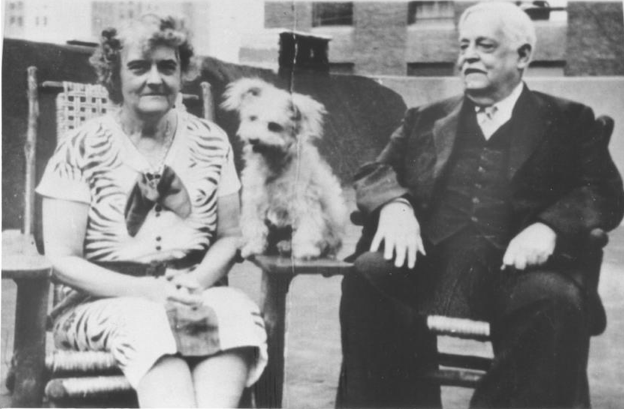Biography: Edward & Carrie Kinney
‘Abdu’l-Bahá gave the early New York Bahá’ís Edward (1863-1950) and Carrie Kinney (1878-1959) names that reflected specific virtues: Edward was named “Saffa” (rock, serenity) and Carrie became “Vaffa” (certitude, fidelity). Later on they also received the title “pillars of the Faith in the city of the Covenant.” Their “pillar”-like qualities were not only demonstrated in their constancy and adherence to the Covenant, they were also exemplified in their strength and faith when facing life-threatening diseases, the loss of two of their three sons at a young age, and economic challenges.
What stands out for me when reading about the Kinneys is how their titles were expressed in the ways in which they created a true home in the physical and spiritual sense: it was a center where Bahá’ís gathered regularly and could fine a refuge in times of destitution or crisis. It was also blessed by being the address for many Tablets to American believers from ‘Abdu’l-Bahá and it was a home where He stayed and delivered several of His talks — including the very first talk given in America on April 11, 1912.
It was in their home that one of my favourite stories took place. This story emphasizes one of the principles of the Bahá’í Faith — namely the belief in the diversity and unity of mankind. Creating a home, a space, in which a transformative encounter of this kind can take place is an ideal many of us are striving towards:
Howard Colby Ives described a lovely scene he witnessed that Sunday at the Kinneys’ home, which by now he was visiting on a regular basis. On this day, looking out the window, Reverend Ives was astonished to see a group of some thirty “noisy, not too well dressed… urchins, but spruce and clean, enter the house.” He followed them upstairs where ‘Abdu’l- Bahá greeted them, one by one, with smiles and laughter. The last one was a dark colored boy and when the Master saw him, His face lit up with a heavenly smile, and He exclaimed: “Here is a black rose!” Everyone present was impressed with a feeling of wonder, which increased when ‘Abdu’l-Bahá, distributing a handful of chocolates to each child with a kind word, picked up a particularly dark chocolate and “without a word, but with a humorously piercing glance that swept the group, laid the chocolate against the black cheek. ‘Abdu’l- Bahá’s face was radiant… and that radiance seems to fill the room.” The children looked with real wonder at the colored boy as if they had never seen him before. “As for the boy, himself… his eyes fastened with an adoring, blissful look upon the Master…For the moment he was transformed. The reality of his being had been brought to the surface and the angel he really was revealed.”
References:
Some Early Bahá’ís of the West, by O.Z. Whitehead (George Ronald, Oxford, 1976), pp. 43-53
Edward B. Kinney, in memoriam, by Juliet Thompson, in Bahá’í World, vol.12, pp. 677-9
Carrie Kinney, in memoriam, by Curtis D. Kelsey, in Bahá’í World, vol.13, pp. 864-5
‘Abdu’l-Bahá in New York, compilation by Lacroix-Hopson, 1987
Photo from www.centenary.bahai.us



I want to thank you so much for doing this.i read this every time Sofie sends it too me.I’m writing a play and this story will be in it.i can’t even imagine how it must feel to always feel less than another and all of a sudden someone who you don’t know makes you feel like a special angel.I wonder what happened to the child
These are fabulous stories and presented in the most beautiful readers: THANK YOU!
Beautiful story.
[…] were invited to the home of the Kinneys. There the Master gave them chocolates and most tenderly taught them about beauty in the diversity of the human race. On 24 April 1912 (Washington) and on 5 May […]
[…] was at the home of the Kinneys that Abdu’l-Baha stayed the second time he came to New York and it was from this home that He […]